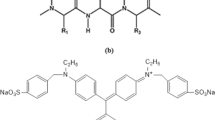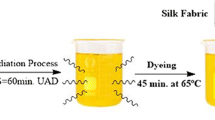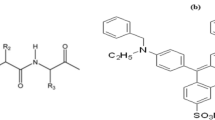Abstract
Alluded to the current collaboration of the environmental technology, this article focused on the ultrasonic efficiency for dyeing silk fabric with sticta coronata lichen in the presence of alum and catechu mild mordants. The spectrophotometer studies on the dye uptake and fixation have been demonstrated, as well as, the influence of mordants and their combination on the colorimetric properties and light fastness. The results indicated that sticta coronata dye had a good substantively to silk fabric with brilliant lilac color. The pre-mordanting process exhibited a significant effect on the color strength, hue, and light fastness depending on the mordant type and concentration. The use of ultrasonic energy is found to have a significant improvement in the dye uptake representing the sonication efficiency in textile dyeing.







Similar content being viewed by others
References
AATCC (2002) Technical manual. AATCC, North Carolina, USA
Antique Rugs of the Future (2004–2009) Azerbaijan Rugs, http://www.azerbaijanrugs.com/arfp-natural_dyes_mordants
Bhattacharya SD, Shah AK (2000) Metal ion effect on dyeing of wool fabric with catechu. JSDC 116:10–12
Burkinshaw SM, Kumar N (2009) The mordant dyeing of wool using tannic acid and FeSO4. Part 1. Initial findings. Dyes Pigment 80:53–60
Country Classic Dye (2008) Natural Dyes and Natural Mordants. A mordant is absolutely needed. Dyes cotton well. Madder Root. http://www.generalbaileyfarm.com/dyes.htm#MORDANTS
Crews PC (1987) The fading rates of some natural dyes. Stud Conserv 32: 65–72
Giles CH, Robert MB (1963) The light fastness of dyes. Text Res J 33:528–577
Gorgani SA, Taylor JA (2006) Dyeing of nylon with reactive dyes. Part 1. The effect of changes in dye structure on the dyeing of nylon with reactive dyes. Dyes Pigment 68:109–117
Gurley S (1994) Improved mordant and method of dyeing. CIPO Patent 2160781
Kongkachuichaya P, Shitangkoonb A, Chinwongamorna N (2002) Studies on dyeing of silk yarn with lac dye: effects of mordants and dyeing conditions. Sci Asia 28:161–166
Kubelka P (1948) New contribution to the optics of intensity light-scattering materials—part I. JOSA 38:448–451
Lewis DM, Loan TTVO (2007) Dyeing cotton with reactive dyes under neutral conditions. Colour Technol 12:306–311
Mansour HF (2009) Environment and energy efficient dyeing of woollen fabric with sticta coronata. Clean Technol Environ Policy. doi: 10.1007/s10098-009-0267-7
Mansour HF, Haroun AA (2009) Ultrasonic efficiency on the photo fading of madder dyed silk using egg albumen and aluminium ions chelating. In: 6th international conference of textile research division. National Research Centre, Cairo, Egypt
McLaren K (1983) The color science of dyes and pigments. Adam Hilger Ltd, Bristol, UK, p 56
Michel MN, Tera FM, Ibrahim SF (2002) Effect of chemical modification of cotton fabrics on dyeing properties. J Appl Polym Sci 85:1897–1903
Mukhopādhyāẏa T (1883) A descriptive catalogue of indian produce contributed to the Amsterdam. Superintendant of Govt. Printing, Oxford University
Sivakumar V, Anna JL, Vijayeeswarri J, Swaminathan G (2009) Ultrasound assisted enhancement in natural dye extraction from beetroot for industrial applications and natural dyeing of leather. Ultrason Sonochem 16:782–789
Vajnhandl S, Le Marechal AM (2005) Ultrasound in textile dyeing and the decolouration/mineralization of textile dyes. Dyes Pigment 65:89–101
Vankar PS, Shanker R, Mahanta D, Tiwari SC (2006) Eco-friendly sonicator dyeing of cotton with Rubia cordifolia Linn. using biomordant. Dyes Pigment 76:207–212
Vankar PS, Shanker R, Verma A (2007) Enzymatic natural dyeing of cotton and silk fabrics without metal mordants. J Clear Prod 15:1441–1450
Acknowledgments
This research was sponsored by Prof. Gerald Smith, the School of Chemical and Physical Science, Faculty of Science, Victoria University of Wellington, NZ.
Author information
Authors and Affiliations
Corresponding author
Rights and permissions
About this article
Cite this article
Mansour, H.F., Heffernan, S. Environmental aspects on dyeing silk fabric with sticta coronata lichen using ultrasonic energy and mild mordants. Clean Techn Environ Policy 13, 207–213 (2011). https://doi.org/10.1007/s10098-010-0296-2
Received:
Accepted:
Published:
Issue Date:
DOI: https://doi.org/10.1007/s10098-010-0296-2




